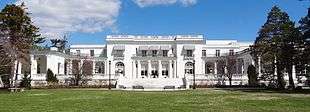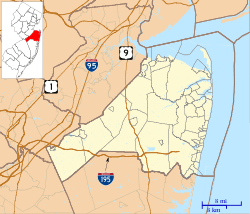Murry Guggenheim House
The Murry Guggenheim House, also known as the Guggenheim Library, is a historic building located at Cedar and Norwood Avenues in West Long Branch, New Jersey.[3] This Beaux-Arts mansion, designed by Carrère and Hastings in 1903 as a summer residence, is now the Monmouth University library.
Murry Guggenheim House | |
 Guggenheim Library | |
   | |
| Location | Cedar and Norwood Avenues, West Long Branch, New Jersey |
|---|---|
| Coordinates | 40°16′56″N 74°0′12″W |
| Area | 7 acres (2.8 ha) |
| Built | 1903–1905 |
| Architect | Carrère and Hastings |
| Architectural style | Beaux-Arts |
| NRHP reference No. | 78001778[1] |
| NJRHP No. | 2082 [2] |
| Significant dates | |
| Added to NRHP | March 28, 1978 |
| Designated NJRHP | May 26, 1977 |
It was added to the National Register of Historic Places on March 28, 1978.
History

In 1903, Murry Guggenheim (1858–1939), son of Meyer Guggenheim, bought property in West Long Branch to build a summer residence for himself and his wife, Leonie.[4] The Beaux-Arts architecture firm of Carrère and Hastings was hired to design the building. The firm had achieved prominence with the design for the New York Public Library in 1897. The mansion was started in 1903 and completed in 1905. An addition was built in 1967 on the north side that doubled the available space for the library.[3][4] In 2003, the library underwent a second expansion, for $14 million, which increased its capacity by 100,000 books.[5]
Description
The building is a two-story Beaux-Arts style mansion with curved side wings and Palladian arcades. The exterior is covered with white stucco. The interior features a grand corridor with Ionic columns.[3]
The design by Carrère and Hastings was honored with a Gold Medal by the New York Chapter of the American Institute of Architects in 1903.[6] It was styled after the Grand Trianon in Versailles.[7]
Legacy
After the deaths of Murry and Leonie, the property transferred to the Murry and Leonie Guggenheim Foundation in 1959. The Foundation then transferred it to Monmouth College, now Monmouth University, in September 1960.[6] After a year of modifications to convert the building into a college library, it was dedicated as the Murry and Leonie Guggenheim Memorial Library on September 24, 1961.[4]
The estate also included a nearby stable and carriage house at Cedar Avenue, which was donated to the college in 1961. It is now the Lauren K. Woods Theater.[8]
References
- "National Register Information System". National Register of Historic Places. National Park Service. July 9, 2010.
- "New Jersey and National Registers of Historic Places - Monmouth County" (PDF). New Jersey Department of Environmental Protection - Historic Preservation Office. January 22, 2015. p. 17. Archived from the original (PDF) on October 16, 2014.
- "NRHP Nomination: Murry Guggenheim House". National Park Service. March 28, 1978. Cite journal requires
|journal=(help) "Accompanying 5 photos, from 1977". Cite journal requires|journal=(help) - "Murry & Leonie Guggenheim Cottage A Beaux-Arts Summer Residence". Monmouth University Library.
- Garbarine, Rachelle (March 23, 2003). "At Monmouth University; $14 Million Addition To Library". The New York Times.
- "College In Jersey Receives Estate; Guggenheim Gift Is 35-Room Mansion on 8 Acres for Library at Monmouth". The New York Times. September 6, 1960.
- Bonomo, Josephine (March 26, 1978). "Monmouth–Learning in Splendor". The New York Times.
- Reme, Jim; Navarra, Tova (2002). Monmouth University. Arcadia Publishing. p. 34. ISBN 978-0-7385-1010-1.
External links
| Wikimedia Commons has media related to Murry Guggenheim House. |
- "Monmouth University Library". Monmouth University.
- Historic American Buildings Survey (HABS) No. NJ-1178, "Murry Guggenheim House", 2 photos
